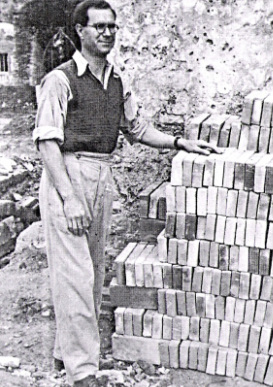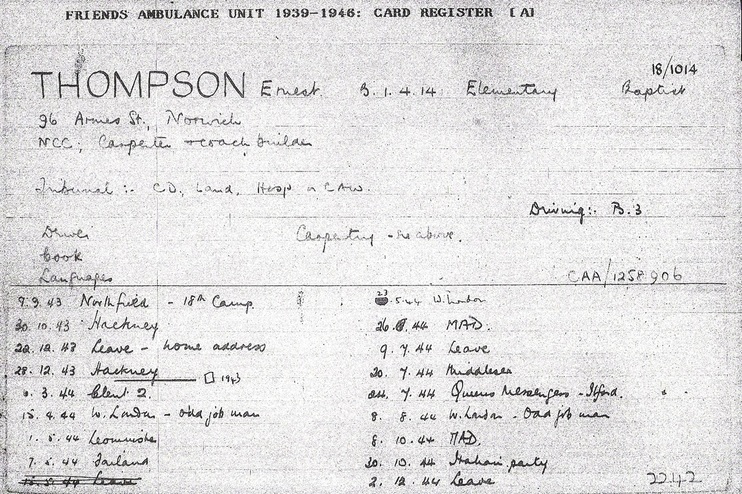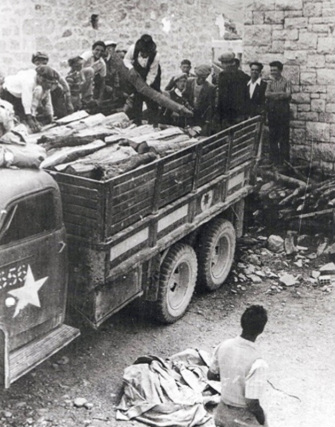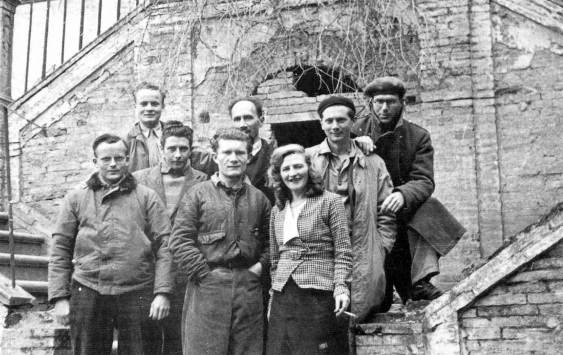Ernest

Ann Cornelisen’s account of Ernest Thompson’s life in ‘Where It All Began’ is, in places, romanticised and in others factually incorrect. Ann did no original research, includes no dates and relied entirely on Gianna’s reminiscences. Quite why Gianna should have given Ann a romantic version is hard to understand and perhaps it was Ann, writing 35 years later, who gave Ernest’s story a romantic gloss. Nevertheless, she writes that Ernest arrived in Italy during World War 2 as a member of the Friends Ambulance Unit. An enquiry at the FAU archive at the Friends Library in London immediately produced Ernest’s FAU record card which included details of his background, education and his movements while a member of the Unit.
He was born in 1914 in Norwich, the county town of Norfolk and, unlike Gianna, he came from a working class background. His father, Joshua, was a shoemaker and his mother, Emma Jane, was a ‘needle sewer’ (UK census 1911). The family lived in a two bedroom terraced house at 96 Armes St. Higham, a working class district about a mile and a half from the city centre. The family also included Herbert (10), Maud (7), (Frank (4) and Edith (2). It must have been a squash when Ernest was born at home on the 1st April 1914 and even more so when Rose followed in 1918. Little is known of his childhood although he was brought up as a Baptist and received an elementary education. He would have left school at the age of 14. He worked as a carpenter and was still living at the family home when he joined the Friends Ambulance Unit in 1943. He was then 29 years old. In ‘Where It All Began’ Ann writes that he interrupted his medical studies to join the FAU and served throughout the North African campaign and the invasion of Italy in 1943. None of this is true. Ernest, far from being a doctor, was a skilled manual worker and his FAU record card makes it clear that he did not set foot in Italy until March 1945 when the war was almost over.
He was born in 1914 in Norwich, the county town of Norfolk and, unlike Gianna, he came from a working class background. His father, Joshua, was a shoemaker and his mother, Emma Jane, was a ‘needle sewer’ (UK census 1911). The family lived in a two bedroom terraced house at 96 Armes St. Higham, a working class district about a mile and a half from the city centre. The family also included Herbert (10), Maud (7), (Frank (4) and Edith (2). It must have been a squash when Ernest was born at home on the 1st April 1914 and even more so when Rose followed in 1918. Little is known of his childhood although he was brought up as a Baptist and received an elementary education. He would have left school at the age of 14. He worked as a carpenter and was still living at the family home when he joined the Friends Ambulance Unit in 1943. He was then 29 years old. In ‘Where It All Began’ Ann writes that he interrupted his medical studies to join the FAU and served throughout the North African campaign and the invasion of Italy in 1943. None of this is true. Ernest, far from being a doctor, was a skilled manual worker and his FAU record card makes it clear that he did not set foot in Italy until March 1945 when the war was almost over.
The notes on his FAU registration card indicate that Ernest was a registered conscientious objector. In 1939 when the war started he was 25 and eligible for military service, and would have appeared before a Tribunal to plead his case for military exemption. Most tribunal records were destroyed after the war so we have no record of the hearing but his appeal was obviously successful. In 1943 he was described on his FAU registration card as a carpenter and coach builder. Conscientious Objectors were usually sent to work away from their homes, just as if they were in the armed forces. It was thought important that they were not seen to benefit from their non-combatant status, (‘Conscience, Government and War’ – Barker), but it appears that Ernest was allowed to remain living at the family home in Norwich.
It is possible that he was already engaged on work vital to the war effort. During the Second World War the largest firm of coach builders in Norwich was Mann Egerton who built the bodies for the Austin K2 field ambulance. Their factory was located about a mile from the Thompson family home in Armes St. It must be considered a strong possibility that at the beginning of the war Ernest was working as a carpenter at Mann Egerton and, on being granted conscientious objector status, was directed to continue in his current employment doing vital war work. This is pure conjecture but what is certain is that in 1943 when he joined the FAU, he was still living at the family home.
The Friends Ambulance Unit was established by Quakers during World War 1 and was designed to find useful war work for socially committed pacifists. It was re-established in 1939. Membership was not limited to Quakers and during the course of the war 5000 pacifists applied to join but only 1300 were accepted. The complement never exceeded 1000. Despite its name the unit was not a corps of stretcher bearers; it saw itself as a small group of well trained individuals who were able to turn their hands to any practical activity. In the early days of WW2 chances to serve abroad were limited but the Unit did useful work in the UK providing medical support in hospitals and especially during the blitz. By 1943, however, ‘….. the Unit was bracing itself for its final effort......civilian relief in the wake of the armies that were to invade Europe from south and north.’ (Tegla Davis: A History of the FAU). Perhaps it was this new focus that attracted Ernest Thompson.
All recruits started their service at a training camp at Manor Farm, Northfield near Birmingham and on the 9th September 1943 Ernest joined the 18th camp. He left Northfield at the end of October and for the next 15 months was constantly on the move serving at several London hospitals, mainly at the West London Hospital but also at Hackney and Middlesex Hospitals. The FAU were mainly employed in support roles, lifting, fetching and carrying for the medical staff. There was no pay and unit members lived together in unit hostels. Because of this and because of the relatively small numbers of people involved, a great sense of camaraderie grew up amongst unit members.
As well as hospital work, members were trained in motor vehicle maintenance. Ernest also spent a week learning to drive heavy trucks. In Staffordshire a haulage contractor ‘had depots for collecting milk from outlying farms. They were short of drivers for the lorries, and the Unit wanted work that would provide training without expending petrol on empty vehicles. An arrangement was made whereby the Unit provided the drivers and the firm paid the equivalent of wages as a contribution to Unit funds. After a few weeks of driving three-ton lorries on long journeys along narrow country roads in winter to collect ten-gallon milk churns from outlying farms, members who before had never held a steering wheel, could claim to be ready for service overseas.” (Tegla Davis)
In June and October 1944 Ernest was attached to the Midland Assembly Depot where recruits were trained specifically for relief work abroad. There were language classes and in November 1944 he was seconded to the ‘Italian Party’. It is not clear where this took place or what form the ‘party’ took but he was given nearly 4 weeks’ leave that Christmas and in February he was posted to Italy.
Thompson and 11 colleagues left London on 16th February 1945 and arrived in Italy on the 1st March. He spent the rest of the year working at several refugee and transit camps until, at the beginning of 1946, he was transferred to Ortona on the Adriatic coast of Abruzzo. He was to spend the rest of his life based there. The entry on his FAU record card reads simply: ‘9.1.46. Aventino’.
The Aventino Valley lies inland from Ortona and to the north of the River Sangro. It was on the north bank of the Sangro Valley that in 1943 the Germans established their winter defences against the advancing allies. The Gustav Line stretched from the Mediterranean north of Naples, via Monte Cassino where the Germans used the monastery as a massive gun emplacement, along the course of the Sangro, to just south of Ortona.
After the winter lull the battle resumed in spring 1944 with renewed ferocity. In Abruzzo hardly a village remained untouched and parts of the province were completely devastated. The German army retreated northwards leaving behind a demoralised, homeless population. A year later people in the Aventino were still living in barns and pigsties, their houses still mounds of rubble. There was an atmosphere of depression and defeatism amongst the local population.
In spring 1945 the FAU, started a small house building programme in the Valley. It was a project for which the FAU was ideally suited: a small group of men would use their skills and ingenuity to work with the local population to encourage them to rebuild their houses. An imaginative approach was needed to obtain the necessary building materials but the main focus was to help the people to help themselves. It was always seen as a pilot project and it was hoped that, if successful, it would act as a model for better resourced agencies.
Four members of the F.A.U., led by a representative of the American Friends Service Committee, arrived in the valley in April. By September the team had grown to twelve, with five three-ton trucks, one small truck, a personnel carrier and a motor cycle. The plan was simple. There was plenty of timber in the woods near the villages. Trees were cut down and the timber taken down to Ortona on the coast in the Unit's transport. There it was bartered for building materials which was then transported back to the Aventino. No money would change hands.
It was not to be expected that the villagers would easily accept strangers into their midst. And yet the response was encouraging from the start. People worked together, rubble was cleared away, new houses built, damaged houses repaired.
In her book ‘Where it all began’, Ann Cornelisen claims that Ernest Thompson was part of this pioneering team, one of ‘The Boys’ whose ‘appetites and idiosyncrasies turned weddings, christenings and rooftree parties into epic celebrations that were followed by just as epic daredevil truck derbies back to Ortona’ . The truth was less romantic: Ernest did not arrive in Ortona until the original Aventino project was about to end.
The project had been a great success and in January 1946 it came under the control of the United Nations Relief and Rehabilitation Authority (UNRRA). Ernest Thompson was seconded to the Aventino Project on 7th January 1946. It may be that he was sent there specifically to organise the transition.
By the late spring of 1946 the FAU had withdrawn from Italy and on the 30th April Ernest officially resigned from the Unit. He transferred to the IVSP (International Voluntary Service for Peace) which organised volunteer work camps throughout Europe. He joined a camp involved with ‘relief work, rehousing and organization of transport’, which had been working in Ortona since the beginning of the year (Archive of Service Civil International). There were 26 volunteers working at the camp and the photograph below was taken in September 1946. Ernest, still in his FAU uniform, is 4th from the right in the back row.
When that work camp ended in December, Ernest remained in Ortona and in January 1947 he joined another IVSP work camp. The picture below was taken in March to mark the departure of Charles Wheeler the leader of both camps. Charles is in the centre of the front row and Ernest is on the right in the back row.
UNRRA continued the house rebuilding programme based on the FAU/Aventino model but it soon devolved its work to an Italian organization, CASAS, literally ‘Autonomous Centre for Help to the Roofless’. In her 1970 history of the American Friends Service Committee, Louise Wood wrote: ‘In March 1947 CASAS put forward its plan for giving welfare assistance to the residents of their new houses. Ernest Thompson took on the job…..One of (his) jobs was to help in deciding what families should be given the new CASAS houses.’
Later in 1947 another agency started work in the region: Gianna Guzzeloni arrived as the representative of the Save the Children Fund.
Click here to go to next chapter
Later in 1947 another agency started work in the region: Gianna Guzzeloni arrived as the representative of the Save the Children Fund.
Click here to go to next chapter




